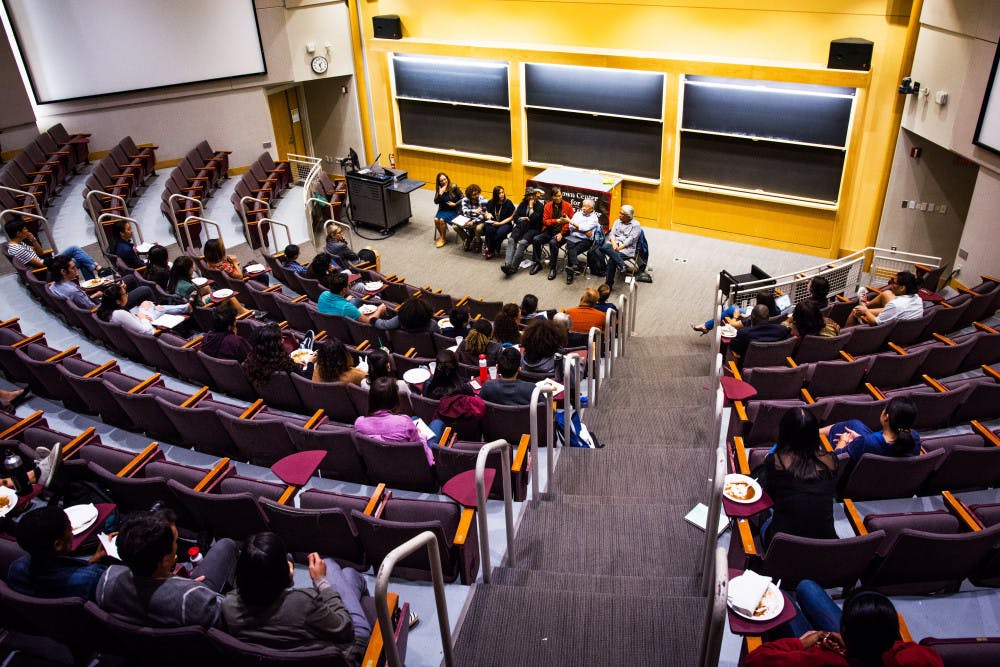The Brown Center for Students of Color — formerly known as the Third World Center — celebrated its 40th anniversary this weekend. The center chronicled its history, hosting a block party Saturday night and a panel of former BCSC directors Sunday afternoon.
Celebrations began at the block party, which was held outside of the BCSC on Brown Street. A diverse set of student groups performed, including Shades at Brown, Divine Rhythm, Mezcla and Mariachi de Brown, which dedicated a song to prominent Mexican singer-songwriter Juan Gabriel, who died last month.
John Robinson ’67 welcomed the block party’s attendees, addressing the University’s history with people of color and in particular its ties to slavery.
Robinson began by focusing on the memory of Inman Page, Class of 1877, who was a former slave but went on to become president of Langston University, a historically black college in Oklahoma. Though many believe “the presence of people of color” at Brown begins with Page, the history begins after 1764 “with the building of the college edifice, University Hall, which was built by slaves … likely brought here on slave ships run by John Nicholas Brown,” Robinson said.
He also touched on the University’s progress in admitting more students of color. Between 1877 and 1967, Brown had graduated fewer than 100 people of color, Robinson said. In 1971, the University graduated more people of color in one day than it had in the past 100 years, he added.
People of color “who graduated in ones and twos did not think of this as our university. Our graduation was, in essence, an acknowledgement of survival,” he said.
Robinson led the creation of the Minority Peer Counselor program. At its inception, the MPC program consisted of only black students. But a couple of years after the MPC program was founded, a Puerto Rican student approached Robinson asking about the inclusion of other minorities within the program. Robinson responded, “solid on down, my brother. Let’s do it!” The MPC program then expanded to include all students of color.
“What I learned through the MPC program is that when people of color can unite and speak with one voice, we’re stronger together,” he said.
The panel of former directors, which included Felipe Floresca ’73, Robert Lee PhD ’80 P’15, Tommy Lee Woon, Karen McLaurin-Chesson ’74 and Mary Grace Almandrez, assistant vice president for campus life and dean of students, discussed several topics including their experiences leading the center and various issues on which students have called for and created change in the past.
During Floresca’s term as director between 1978 and 1980, students advocated both need-blind admission as well as full divestment from South Africa and against police brutality by the Providence Police Department.
Lee, who directed the center between 1981 and 1985, said building solidarity and alliances with other spaces on campus like the Sarah Doyle Women’s Center was a point of focus for him, as well as extending fellowship with the Providence community.
During his time as director between 1990 and 1993, Woon experienced difficulties because the administration did not give financial priority to the space, he said. A lack of funding led to problems — including providing food for student gatherings and acquiring basic office supplies, as well as leading the MPC program with only one or two staffers at hand.
McLaurin-Chesson, who was both the first female and longest-standing director of the center, served from 1993 to 2010 and spoke about the importance of hearing and amplifying student concerns.
During her first semester as a student at Brown, she faced academic hardships, which strengthened her compassion and sympathy with students when she later became the first black dean of student affairs. She served as dean of student affairs at the same time she served as director of the center. During her time in administration, Brown students faced issues including trans* rights, need-blind admission and concerns with financial aid.
McLaurin-Chesson began the center’s yearly retreats for its staff members to build trust and collaboration among various cultural groups, she said. She also transformed the interior of the BCSC to be more warm and inviting and oversaw the implementation of a wheelchair ramp to make the building more accessible.
“Through the years, there’s nothing greater than making a difference on the quality of life at Brown, but it is a topic that always needs to be revisited,” she told The Herald. “I was a voice for students and a voice of reason for students. I attempted to give them the information they needed to be productive in society. They’re what made me smile every day.”
Today, the impact of the center should be credited to “the people who utilize and invest in the space,” said Joshua Segui, current director of the BCSC.
“The conversations that communities of color have at the center … and other spaces” impact Brown’s culture, he said, adding that students of color “advocate for themselves and future generations.”
For many students, the BCSC is a gathering space to study and socialize, Segui said. “Sometimes people just want to be in a space that recognizes, appreciates and celebrates their particular culture and identity,” he added.
Students today should continue to reflect on the center’s history, especially since what they “enjoy has been hard fought for and well worth preserving,” Robinson said.
“You owe us memory. Keep it alive,” Robinson added. “You owe me unity. You owe me being stronger together. You owe me getting a damn degree.”





